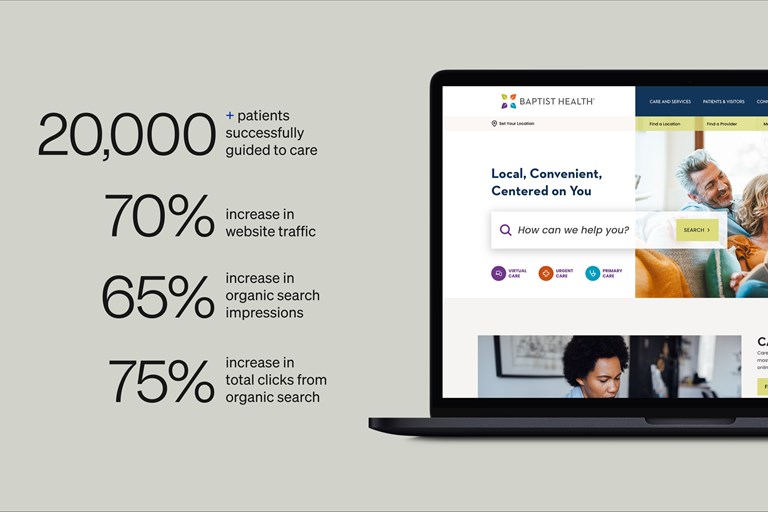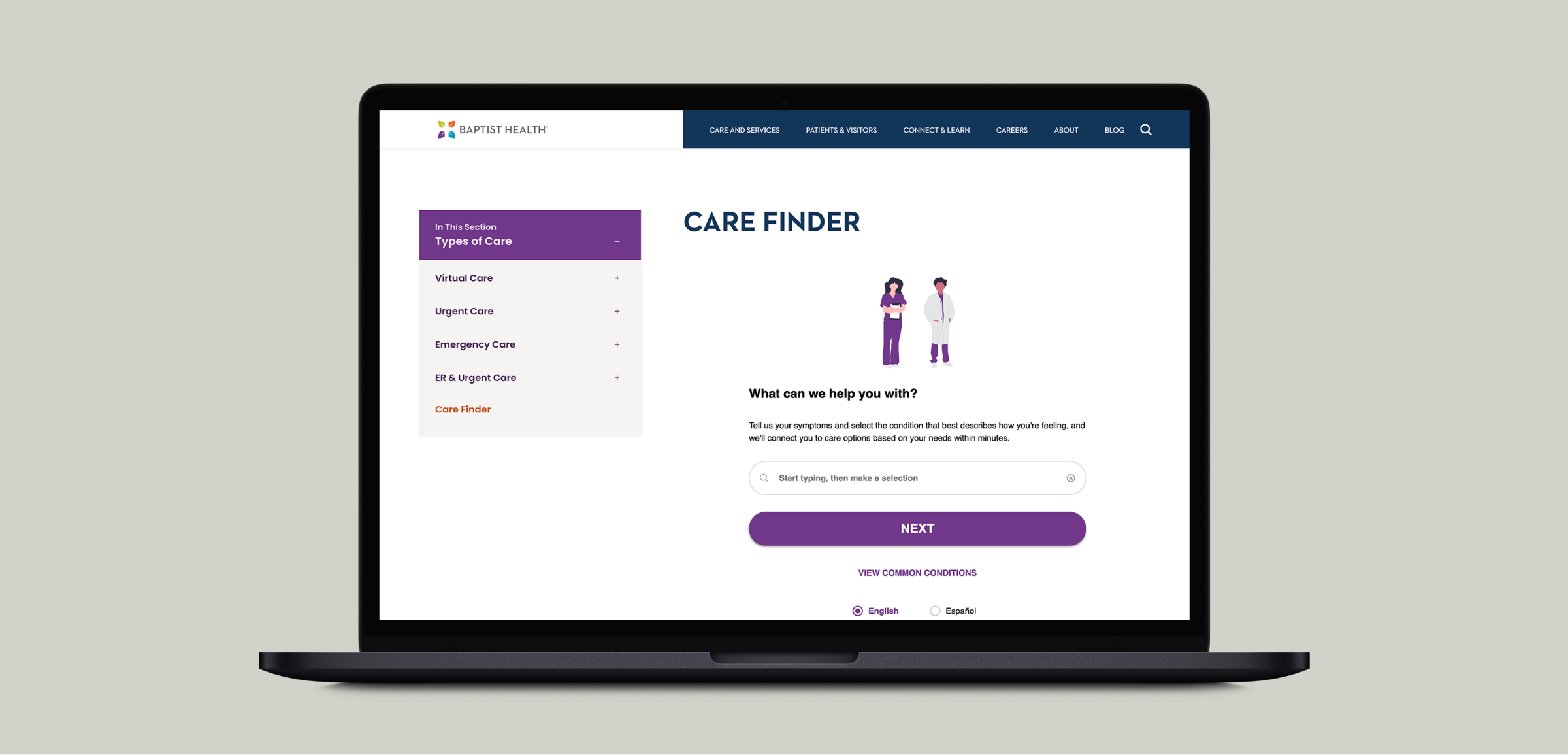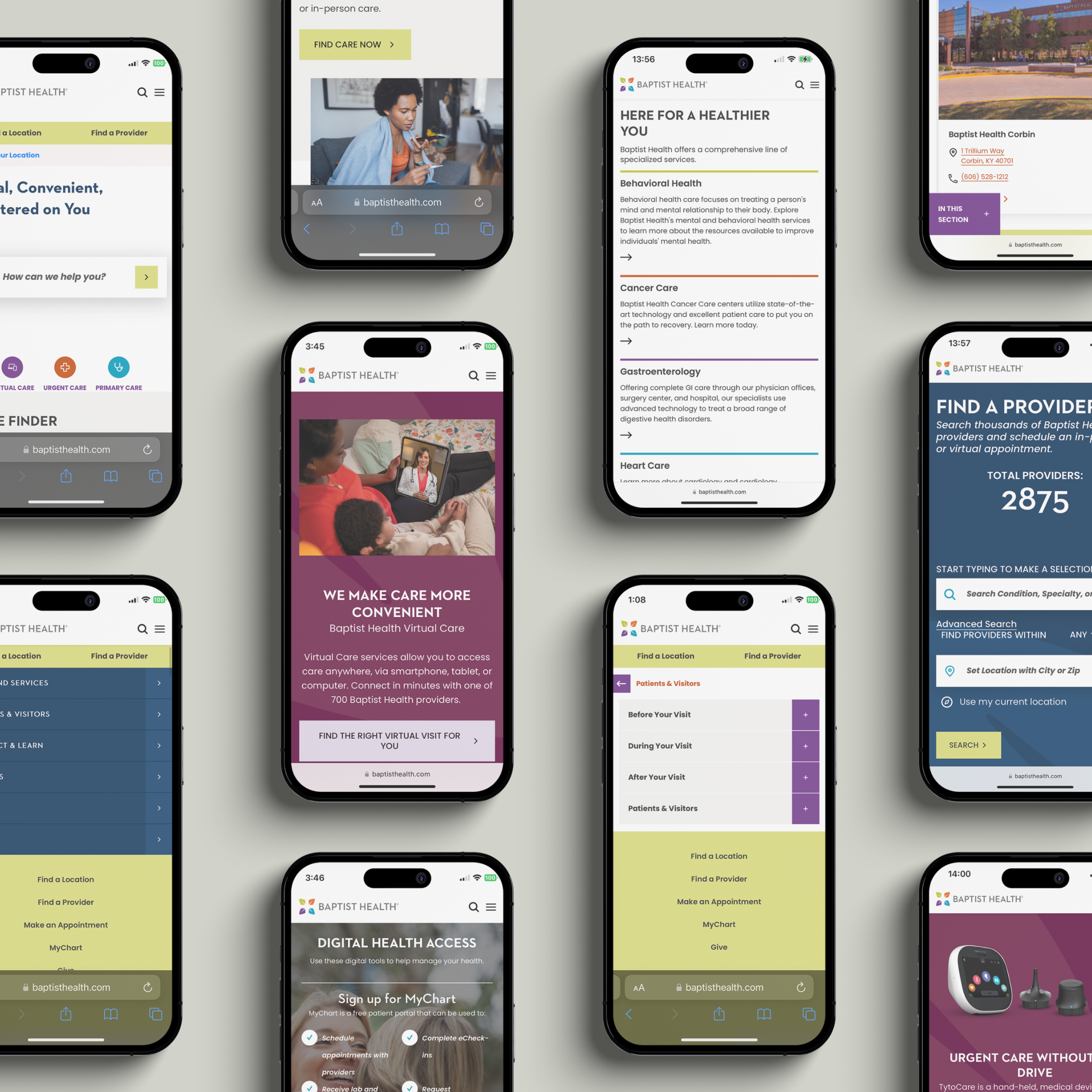Baptist Health
Experience elevation helps thousands of Baptist Health patients find care
A leap in strategy and tech capabilities that gives people in Kentucky and Indiana a better way to navigate healthcare

Facts
Industry
- Health
Service
- Experience Elevation
Technology
- Salesforce
- Sitecore

Get to know Baptist Health
Baptist Health
Baptist Health is a regional health system covering Kentucky and Southern Indiana.
The system’s nine hospitals and 400-plus points of care serve a geographically diverse region. The 5 million-plus people in Baptist Health’s region are spread across two metropolitan areas, a handful of fertile plateaus, and a rugged section of the Appalachian Mountains.
A significant number of these people live in rural areas. This makes it challenging for some people to access care. Someone who lives in a farming community might have to drive 20 or 30 miles to reach their nearest point of care. Someone who lives in Eastern Kentucky might have to navigate a steep mountain pass to get to an urgent care facility.
Telecommunications availability further complicates care access. In some of the region’s most rural communities, home broadband is not available, and mobile internet service can be spotty.

Navigating a fractured patient experience
Baptist Health
For patients, the website for a single hospital can be complex and hard to navigate. If that hospital’s site lacks a coherent taxonomy, finding information about treatment areas or which specialists are available, and when, can be time-consuming.
Now, scale that frustration up to nine hospitals, 400-plus points of care and 5 million people.
Here is an example of what that might look like: A patient in Scottsburg, Indiana, needs to see a doctor about her osteoporosis. Baptist Health is within her insurance network, and there is a local Baptist Health clinic. But is there an osteopath there? Or should she check the Baptist Health Floyd hospital down in New Albany, which is a half-hour drive down I-65?
Baptist Health’s original network of websites would have made it difficult for this patient to get an answer. That’s the essential challenge Baptist Health asked us to solve.
That challenge had several complicating factors:
-
Patient digital experience expectations. Patients expect more from healthcare provider digital channels than they used to. People are used to seeing personalized content. People are used to convenience. They can track their pizza deliveries in real time, so why is it so hard to book a session with a physical therapist or find out how much a visit to the doctor will cost?
-
Disunity among service lines and locations. Many of the points of care in Baptist Health’s network did not begin as Baptist Health points of care. They joined the network over time. As such, many of their digital presences behaved as standalone entities. A local clinic and regional hospital could have operated under the same Baptist Health name for 10 years, but from a patient experience perspective there was nothing to facilitate a seamless handover from one to the other.
-
Geography. For patients in Appalachia, the closest point of care might not be the best place to send someone. A clinic 20 miles away along a state highway could be more accessible than a clinic 4 miles away along a winding local road.
Unifying the experience with better data and content management
Baptist Health
Baptist Health implemented the Kyruus data management system, a best-of-breed solution built specifically for healthcare providers. This provided an internal taxonomy that unlocked many crucial patient experience capabilities.
The updated taxonomy let us make several important changes to Baptist Health’s digital channels:
-
We built a care finder tool with profiles for all the healthcare professionals Baptist Health employs and works with. Users can now easily see a physician’s specializations, where they practice, what credentials they have and how patients rate their treatment. It even understands what kind of relationships those professionals have with Baptist Health (e.g., affiliated with the Baptist Health Medical Group), which embeds business logic in the taxonomy.
-
We elevated the Baptist Health blog and integrated that information into user experiences. The new blog allows for articles to have multiple category tags and shows related content based on those tags. It also features a feed that allows for publishing blog content across channels to support Baptist’s digital marketing.
-
We tagged providers and content with more colloquial terms so patients could search for “heart health” and get the same information as if they searched “cardiac health.”
Another key tech upgrade was migrating content from WordPress to Sitecore. Sitecore is a much more robust content management system, and it’s more secure. Third-party plugins on WordPress can too easily create security vulnerabilities when small developers stop updating. Sitecore solves that problem.
Sitecore is also easy to integrate. Developers just need an API. This unlocked new customization options for presenting Baptist Health content.

Results
Baptist Health
In 2023, Baptist Health launched an integrated digital ecosystem that unified patient experiences across channels and points of care.
Recent guidance in HIPAA compliance limits the visibility we have into usage statistics, but there are some key results we can share:
More than 20,000 patients have been successfully guided to care via the care finder tool.
BaptistHealth.com saw a 70% increase in total visits in the fiscal year 2022.
The site saw a 65% increase in total organic search impressions in the six months post-launch.
Total clicks from organic search rose 75%.







